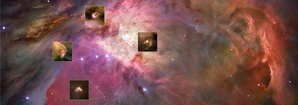Protoplanetary Disks in Orion

A group of UA scientists ( Steward Professor Josh Eisner, Associate Astronomer Serena Kim, Steward Postdocs Nick Ballering and Min Fang, Steward Grad Student Ryan Boyden, and LPL Associate Professor Ilaria Pascucci) and their collaborators have used the ALMA telescope to image protoplanetary disks in the Orion star forming region. You can read the press release HERE. Josh Eisner has kindly written a couple of paragraphs that you can read below.
"Protoplanetary disks are the birth-sites of planets. A team of scientists led by the University of Arizona has imaged a cluster of protoplanetary disks in the Orion Nebula and discovered that they are smaller than those previously studied in closer, less-dense regions. These disks are similar in size to theoretical models for the protosolar nebula.
Given that our own solar system (and most systems in the Galaxy) likely formed in an Orion-like environment, this finding suggests that we may be observing typical planetary systems in the making.
The team's findings have been published in the Astrophysical Journal. The scientists used the largest telescope in the world, an interferometric array of radio telescopes in Chile called ALMA, to observe about 110 protoplanetary disks in the Orion Nebula in the deepest survey of the region yet. Based on the images, the team was able to calculate the masses and sizes of protoplanetary disks in the Orion Nebula. Their survey showed that Orion, with its massive stars and high stellar density, has disks that look significantly different than those in nearby, but less-dense regions. To confirm the effects of environment on the star and planet formation process, U of A scientists are pursuing grant funding and telescope time to study more regions of dense, high-mass star formation."

For Public
Public events include our Monday Night Lecture Series, world-reknowned Astronomy Camp and Mt Lemmon Sky Center.

For Students
A good place to start if you want to become an undergrad major or grad student, or need to find our schedule of classes.

For Scientists
Find telescopes and instruments, telescope time applications, staff and mountain contacts, and faculty and staff scientific interests.




